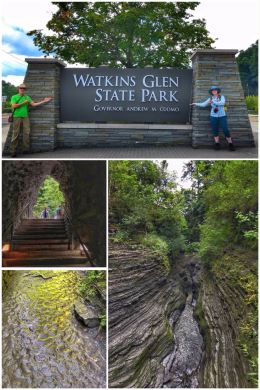
Just wow. We had forgotten how much we missed the mountains and trees and beautiful vistas until we arrived in the 9,000-square-mile Finger Lakes region of New York (state #31 on this amazing adventure). Located in central New York, the Finger Lakes consist of a group of 11 long, narrow, roughly north–south glacially-created lakes. The lakes range from very small (Canadice at about 4 miles long) to very large (Cayuga at 38 miles long).
From west to east, the Finger Lakes are Conesus, Hemlock, Canadice, Honeoye, Canandaigua, Keuka, Seneca, Cayuga, Owasco, Skaneateles, and Otisco. The region includes dozens of amazing, cascading waterfalls as well as deep, long gorges, sparkling lakes, and lush rolling hills. It also includes acres of beautiful forestland, farms, and vineyards.
Native American legend has it that the lakes were formed when the Great Spirit was pleased and looked favorably on the region, offering his blessing by placing his fingers upon the land; the pressure from his fingers left indentions that filled with water, forming the pristine lakes scattered along the sacred ground.
We started our adventures in the Finger Lakes near Seneca Lake, with one of the best-known state parks in the area: Watkins Glen State Park, an 800-acre park best known for its 400-foot-deep narrow gorge cut through rock by Glen Creek, which created 19 different waterfalls. Amazingly, the land was made available to the public in 1863 and was privately run as a tourist resort (including the stately 3-story Glen Mountain House hotel) attracting thousands of people from around the world until 1906 , when it was purchased — and protected — by New York State.
The geology at the park is fascinating. The rock in the gorge is about 380 million years old and started as the bottom of a shallow ancient sea at the base of steep mountains that eventually eroded. In the lower left photo above, you can see the preserved ripple marks in the rock from when the ancient sea covered much of this area. And as recently as 12,000 years ago, there was no gorge; Glen Creek flowed at the top and has slowly eroded the canyon and formed the gorge.
Expect the park and trails to be crowded — and the hiking a bit grueling — but the sheer beauty of being next to the falls and deep in the gorge is something that simply HAS to be experienced. All the trails here are open mid-May to early November.

We started by hiking the Gorge Trail. Full disclosure: this trail includes about 800 stone steps as you travel up and through the gorge; it is not an easy hike by any means — but it is also not that long. In under two miles, you’ll hike a trail that winds over and under waterfalls (including through the spray of Cavern Cascade) while deep in a gorge with 200-foot cliffs.
You can park on the east or west end of the gorge, but we recommend hiking the Gorge Trail from the east (main entrance) side so that you will experience each falls as you move upstream along the creek — including Minnehaha Falls, Cavern Cascade, Diamond Falls, Central Cascade, Pluto Falls, and Rainbow Falls. The start of the hike here is more dramatic too, as you enter the gorge through an entrance tunnel that was hand-cut into the rock in the early 1900s and across Sentry Bridge over the creek.
Once you get to the west side (upper entrance), which includes restrooms, snack bar, and picnic area, you can either hike back via the Gorge Trail, or, as we did, loop back along the Indian Trail along the top of the gorge, which is much quieter and has a LOT fewer steps than the Gorge Trail. One can also hike along the other side of the gorge along the South Rim Trail (which actually leads to a third parking area and entrance). We did the Gorge-Indian Trail Loop, which totals about 2.7 miles.
One final note about the park. As we have discovered with many other parks around the country, Watkins Glen was aided by a crew of Civilian Conservation Corps (CCC) — who arrived in July 1935, just days before the Great Flood caused extensive damage in the park. The CCC rebuilt and made improvements so that the park could reopen the following year. Much of the stone masonry in the park was completed by the CCC.
Finger Lakes Chosen as America’s Best Wine Region
The Finger Lakes area is the state’s largest wine-producing region. More than 120 wineries and vineyards are located around Seneca, Cayuga, Canandaigua, Keuka, Conesus, and Hemlock Lakes. The lakes provide a beneficial effect to the lush vineyards that flank their shores — and grape-growing in the region dates back to 1829. According to the national USA Today 10Best Reader’s Choice poll, the Finger Lakes is America’s favorite wine region — besting Napa, Willamette Valley, Sonoma, Lodi, and other major wine regions. Wine and tourism generate $2.8 billion to the local economy annually, according to the Finger Lakes Regional Tourism Council.

Thus, after the fun hiking at Watkins Glen, it was time to experience some of the wineries along Seneca Lake AVA. Ran remembered Finger Lakes wines as sweet and light, but we discovered in our research that the region has expanded and growers have planted Cabernet Franc and Pinot Noir grapes and that dry reds are gaining ground at many wineries! There are 31 wineries that belong to the Seneca Lake Wine Trail, but many other wineries are also located along the lake — and we visited two of them. We started at Barnstormer Winery and finished the day at Shaw Vineyard.
Barnstormer, a boutique winery just four miles north of Watkins Glen, focuses on dry and off-dry whites and reds using only grapes grown in the Finger Lakes region, producing about 2,500 cases annually. (We also stopped here because they offer three wines under the “Jenny” label.) The winery is located in a 170-year-old barn and offers visitors a choice of five wines (from about 20 in their current selection) for $6… paid up front, which kind of jarred us because we typically pay for tastings when we have completed them (and the optional wine purchase). We tried a variety of their wines — including a Blaufrankisch, a new grape for us — but found the wines a bit tart. On the plus side, they offered us several recommendations for other wineries offering quality dry reds, starting with Shaw Vineyard. (Others recommended included Red Tail Winery, Burdett, Hector Wine Company, Lieidenfrost, and Shalestone.)
Shaw Vineyard, located on NY-14 in Dundee (abut 14.4 miles north of Watkins Glen), is an artisanal winery dedicated to serious, dry reds, created with “gentle processing, cellar aging, and risk-taking.” They also believe in sustainable viticulture and fine agricultural craftsmanship — a big plus for us. Red wines at Shaw are held for years — typically 5 or more — in the cellar, predominantly in neutral French oak, allowing for natural aging and tannin softening. We enjoyed several tastings of their reds — all from 2010-2012 vintages. We enjoyed chatting with Steve Shaw, the owner, and especially appreciated that the tasting was done in big, crystal wine glasses. We left with an appreciation of Steve’s art of wine-making, a tee-shirt, and a bottle of the 2011 Cabernet Sauvignon Reserve.
Red House Ranch: Raising Animals the Right Way
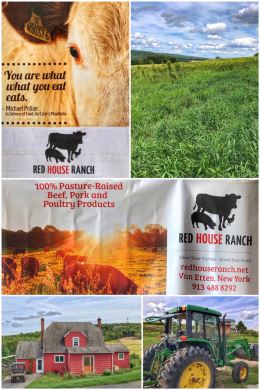
As fun as the first day was, we were extremely excited about the next day in the Finger Lakes, because we were traveling to Red House Ranch, LLC, located in Van Etten — about 33 miles east of Corning; 23 miles southeast of Watkins Glen; 22 miles south if Ithaca. We found Red House Ranch on EatWild.com, a great website for finding local ranchers and farmers offering grass-everything meats, as well as fruits, vegetables, eggs, and dairy products — grown without pesticides, herbicides, etc. Red House Ranch can also be found on LocalHarvest.com, another wonderful site that is about connecting consumers looking for good food with the farmers who produce it. Ran discovered that Red House Ranch had pastured beef and pork, as well as eggs from free-ranging chickens, so we contacted Ike Mallula (one of two brothers who own/run/manage the ranch; Dave Mallula is the other) and were invited for a tour. The ranch only started production in 2016, but the land had been in the family for decades — and the brothers decided it was their time for bringing back land into farming and ranching.
We absolutely love and appreciate that all of Red House Ranch products are 100 percent grassfed start to finish, and raised without the use of industrial fertilizers, herbicides, insecticides, antibiotics, or growth hormones. We were also impressed that they utilize sustainable techniques including mob grazing and silvopasture.
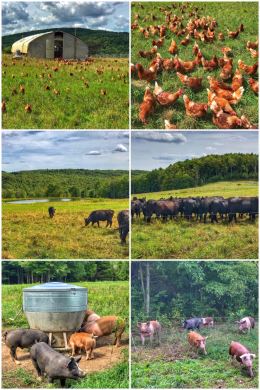
Our tour started with a drive up to where the laying chickens are housed. The ranch has thousands of Hy-Line Brown hens (the world’s most productive brown egg layer) in several temporary, moving facilities — again, to maximize the health and use of the pastures… and to let the chickens be chickens. (The chickens are also fed supplemental, organic, non-GMO feed.) It was absolutely crazy and wonderful to have all these happy hens running toward us when we arrived — and their clucking was almost overwhelming; we had to shout to be heard over all those happy hens. These chickens produce many, many dozens of fresh eggs daily. It is an amazing operation.
Next up were the pigs, who came charging out of their temporary location in the woods. The pigs are also rotated to different forested areas and allowed to root and feed off the land, though supplemented with non-GMO feed. Pigs are highly intelligent and raising them in forest areas provides the most stimulating environment to complement their innate curiosity. The pigs are currently a mix of breeds, though Red House Ranch is moving toward having Mulefoot pigs.
We then traveled over to where the cows were currently happily pastured. Red House Ranch uses the mob grazing technique in which the cows are frequently moved to different pastures to obtain optimal nutrient availability of the grass. Like many other ranchers raising truly grassfed, pastured cattle, it was partly a lecture on grazing techniques by Joel Salatin of Polyface Farm, Inc., that inspired the creation of Red House Ranch… at least the cattle part of the business.
Ike believes in the mantra — just as we do — that “food is medicine.” We spent much time discussing Michael Pollan and Food Inc., and the sad state of our food system today where even if you want to try and buy healthy foods, the labels using words such as “natural” and “cage-free” and “grassfed” mean next to nothing. Just FYI: Most “grass-fed” beef at your local grocery store is not grass-finished and most not even from the U.S., but imported from Australia. If you want the best meats, you HAVE to buy locally from your local rancher — like Red House Ranch.
Furthermore, we as a society also eat way too much processed, sugared foods. As Ike discovered, the Low-Carb, High-Fat (LCHF) lifestyle profoundly improved his health and helped him realize that there is a demand for pasture-based animal production. Now we have to support these ranchers doing the right thing!
We absolutely love this story about Dave and Ike: “After growing up on a farm, moving to the city, going to college, and spending 30 years at desk jobs, they have now found themselves being drawn back to their family farm. Rather than retiring and spending idle days playing golf, Dave and Ike are excited to produce quality food with sustainable methods that will encourage others to take make the leap from office cubicle to sustainable farm.”

There is NO question these brothers are doing things right and have an amazing ranching operation. More importantly for us as consumers, they are raising these chickens, pigs, and cattle in the best way possible — out in pastures and in the sunshine. Animals raised on pasture inherently produce more nutrient-dense proteins and fat while at the same time sequestering carbon, improving the fertility of the land. And eggs from truly pastured hens are one of the healthiest and tastiest foods you can eat, providing nutritional benefits because they are rich in vitamins and proteins.
As we ended our time at the ranch, not wanting to take up any more of Ike’s time, we left with a hope that more of us will embrace our local farmers and ranchers — and by doing so, enhance our health and well-being. It was also one of those times when we wished we had a mega-freezer in our travel trailer so we could really stock up on this healthy beef… but we did manage to purchase about nine beef fillets, one London Broil, and one bag of ground beef… as well as two dozen fresh eggs.
While we could talk all day about how important diet and nutrition are to your mental and physical well-being, it was time to get hiking out in nature — one of the other keys to healthy living… so we headed to Buttermilk Falls State Park, an 811-acre state park located southwest of Ithaca.
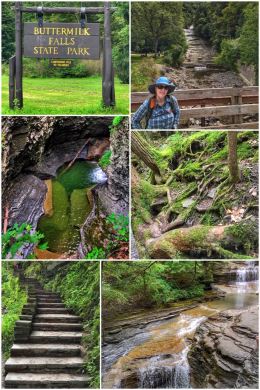
The park is similar to Watkins Glen with gorge and rim trails (and lots of stairs) — but much less crowded. It takes its name from the foaming cascade and falls formed by Buttermilk Creek as it flows down the steep valley side toward Cayuga Lake. We parked at the main park entrance, but there is also an upper parking lot on Upper Buttermilk Falls Road.
We hiked the .65-mile Gorge Trail up through the gorge, enjoying the many cascading falls and high cliff walls… and all those steps! We then returned via the .82-mile Rim Trail (which can be accessed by crossing over King Road). The Rim Trail does not offer many views, but is much easier on the knees as you simply hike down a sloped trail back to the parking lot. If desired, you can also hike the 1.29-mile Lake Treman Trail (which also hooks up with the Finger Lakes Trail) and the 1-mile Larch Meadows (nature) Trail.
Afterwards, we considered continuing on to Taughannock Falls — and we did stop at the state park to soak up some vistas of Cayuga Lake — but it was hot and humid and we were just too exhausted to do another gorge hike. Taughannock Falls has a reputation as being one of the prettiest falls in the area, plunging 215 feet past rocky cliffs that tower nearly 400 feet above the gorge. Gorge and rim trails offer spectacular views from above the falls and from below at the end of the gorge trail.

After admiring Cayuga Lake, we decided to do a little wine-tasting at one of the wineries along the lake — as well as some cheese-tasting. We had thought about Swedish Hill Vineyard (mainly because of Jen’s heritage), but it was a bit too far of a drive, so we decided on Frontenac Point Vineyard (which is along the lake but not part of the 12-winery Cayuga Lake Wine Trail). We had a nice tasting there, but none of the wines spoke to us, so we moved on to Lively Run Dairy — where you can visit the goats — which we did — and do a wonderful goat-milk cheese tasting flight, including Chevre, Feta, Gouda, Cheddar, and two Blue Cheeses (one goat, one cow). The tastings are quite nice — but like most wine-tasting — there’s a fee for the tasting. We finished up at Sunset View Creamery, which offers a very informative self-guided tour of the dairy. Their store offers free tastings, as well as cheese and dairy products and local eggs and other gifts.
The next day was all about Corning, New York, a town of about 11,000 that was named for Erastus Corning, an Albany financier and railroad executive, and that is home to the Fortune 500 Corning, Inc. (formerly Corning Glass Works), a manufacturer of glass and ceramic products for industrial, scientific, and technical uses.

We started the day with a hike in nature to the Houghton Land Preserve, a 194-acre mostly hardwood forested park located on a hilltop above Corning, not far from Corning Community College. Much of the preserve is overgrown — with woods dominated by oaks and hickories interspersed with birch, maple, and pitch pine… as well as hemlock. There is also an open field that once was used for agriculture.
The preserve offers a few trail options that partly loop through the property. It is one of the few very-well marked trail systems… and we ended up hiking about 1.5 miles.
The land was donated to the Finger Lakes Land Trust to be set aside as a nature preserve by Jamie and Maisie Houghton; Jamie Houghton is the great, great-grandson of the founder of Corning, Inc., and who served as a top executive of the company for several decades.
Reflecting on the Beauty (and Versatility) of Glass
Of course, the biggest attraction in Corning is the Museum of Glass, located downtown and across from the Corning factory. It was founded in 1951 — though much of the building used for the museum today is only a few years old. It houses one of the most comprehensive collections of glass with a compilation of more than 50,000 glass objects, some thousands of years old.
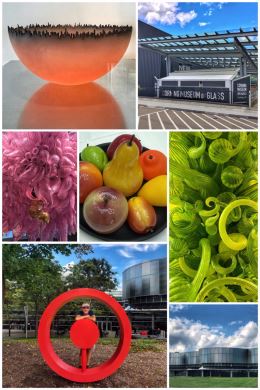
The museum offers numerous galleries, live hands-on demonstrations on various aspects of glass, and the opportunity to blow your own glass souvenir… as well as a very massive gift shop.
Glass is used extensively in our society — from the fiber optic cables that carry our high-speed internet to the windows in our cars and buildings to fine wine glasses to ornaments and art installations. Glass is everywhere. Per their website: “Glass is a versatile, ancient material that is still being explored and understood by artists, scientists, and historians today. The story of glass is a story about art, history, culture, technology, science, craft and design.”
We have to say that this facility is one of the most beautiful we have ever seen — and the glass collection simply outstanding. They have several pieces from Dale Chihuly (the green and pink pieces in the collage) and the beautiful Cityscape bowl by Jay Musler, as well as galleries on ancient glass, contemporary glass, glass and science, and special projects. Admission is amazingly free for children (under 17), and adults pay $20 per person (with some discounts available)… well worth it. The museum’s mission statement is “we inspire people to see glass in a new light” … and you will indeed after spending a day experiencing all the museum has to offer.
The museum is also a center for glass scholarship and education. It houses the world’s foremost library on glass as well as one of the top glassworking schools in the world.
We ended the day in Corning with another short walk — on the Painted Post Trail, which begins at Craig Park on the western side of town. The wide and wavy asphalt surfaced rail-trail goes through neighborhoods and connects with other trails. The Painted Post railroad depot sits along the trail near Steuben Street, and has been restored — today serving as a railroad museum staffed by volunteers.
The next day we moved on to the Keuka Lake area, starting in Penn Yan — with another day of nature and wine-tasting. (Penn Yan is named for the two groups of early transplants from Pennsylvania — PENN — and New England — YAN-kees.) We started by hiking the Keuka Outlet Trail, which runs for 7 miles between Penn Yan and Dresden, following a railroad corridor built on a the towpath of the former Crooked Lake Canal (1833) dug along the natural drainage of Keuka Lake Outlet between Seneca Lake and Keuka Lake. The canal had 27 locks, but was abandoned in 1870s, though one (Lock #17) still exists along the trail and can be found just north of the ruins of the Seneca Mill (which was built in 1884 using stone foundations from blocks salvaged from four of the abandoned canal locks).
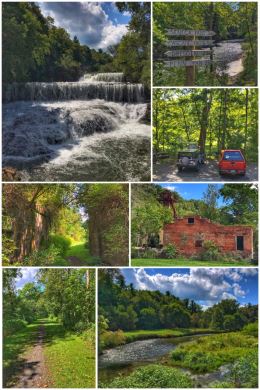
The trail has a bit of a rough surface, so better for off-road bikes; hiking it was not an issue — though finding a place to park was. We parked in a very tiny lot right off Ridge Road (Route 9) about 3 miles east of Penn Yan… but as we hiked the trail, we found a much bigger parking area (with porta-potty) located along Outlet Road.
We hiked the middle portion of the trail because we wanted to see the two falls and the remains of the mill sites, but if you do the entire trail, there are other former mills and additional canal locks. Seneca Mills Falls (shown in the top left of the collage) drops more than 40 feet in three cascades at the former paper mill site. There’s a nice picnic area here named the Hansen Pavilion. About 1.3 miles east of Seneca Mills Falls is the
20-foot Cascade Mill Falls. These falls are not as dramatic, but the ruins and old buildings of the J.T. Baker Corp. are definitely very fascinating.
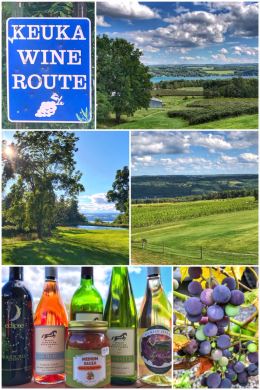
After getting our nature fix, it was time to visit some more wineries — and we decided to take advantage of the Keuka Lake Wine Trail Passport, which for $15 gets you “free” tastings at all five member wineries — as well as other coupons and deals. There are other wineries around the lake that do not participate in the wine trail, but we only had a limited amount of time, so stuck with the member wineries.
We left Penn Yan and decided to attempt a counterclockwise wine-tasting trip around Keuka Lake (which is shaped like a “y”), starting with Vineyard View Winery, which is located about 4 miles southwest of town. The views from this winery are quite wonderful and the tasting room light and airy. This family-owned operation is now in the fifth generation of growing grapes — although the winery has only existed since 2013. Adam Folts currently tends to Folts Farm, which grows mostly native grapes and some French-American hybrids. Their focus is mainly on dry wines.
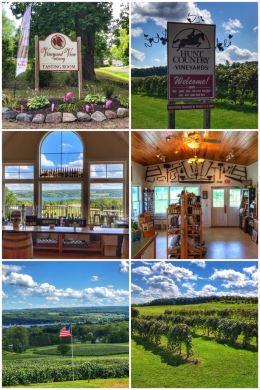
Visitors have a couple of options for tastings, including a regular tasting or reserve tasting for $3 per wine. As part of the Wine Passport, we had a regular tasting (including a Blaufrankisch, Marquette, and Cabernet Franc). Sadly, we were not really impressed with any of their wines, so we hopped in the truck and headed down the road to Hunt Country Vineyards.
The Hunt family have been farming in this area for seven generations! They have a focus on responsible farming (including soil health and beneficial habitats) and have been making wine since 1981. They have also installed a 348-panel solar system that provides most of the electricity for the vineyard, as well as a geothermal heating/cooling system.
Hunt also offers both standard and reserve tastings, as well as ice wine tasting. You can also get a chocolate and wine pairing or a cheese and wine pairing. We had a blast tasting here and are happy to report we enjoyed several of their wines, leaving with a bottle of the Remedy (a carbonated rose), Alchemy (a blend of Cabernet Franc, Merlot, and Cabernet Sauvignon), and Traminette — as well as two bottles of local Salsa (which we love on our Siete Grain-Free Tortilla Chips).
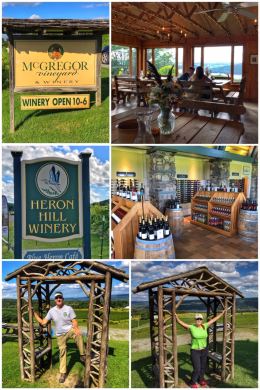
Next up on the tasting adventure was Heron Hill Winery, located on the southwest end of Keuka Lake. They have been around since 1977 and also practice sustainable viticulture. Their tasting room is pretty dramatic and beautiful — and also offers outstanding views of the vineyard and the lake. Heron Hill also offers a regular and reserve tasting. We enjoyed the atmosphere and had a wonderful server who entertained us as we tasted. We left with a bottle of their Eclipse (a Bordeaux-style blend of Cabernet Sauvignon, Merlot and Cabernet Franc) and Lady of the Lakes Riesling (a slightly effervescent semi-dry Riesling). (The winery is among the leaders in recognizing Riesling as the region’s flagship varietal, although we love the reds they are growing here.)
We ended the tastings at McGregor Vineyard Winery, on the eastern side of the lake. Like many of the other wineries, the family has been growing grapes for years and producing wines since 1985 — and are considered pioneers of dry red and white vinifera wines — as well as home to the “legendary” Black Russian (red) wine. They were sold out of the Black Russian, but we were able to taste their 2017 Saperavi an ancient wine grape originally from the country of Georgia on the Black Sea. We also tried two of their Pinot Noirs, a Merlot, and a red blend — but none of them grabbed us.
And with that, our time in the Finger Lakes was over. This area is truly worthy of a long visit… the nature is amazing with gorges, waterfalls, beautiful forests, rolling hills, and wonderful scenic byways and trails … and the wines are quite good and getting better. For racing fans, there is also Watkins Glen International, which we did not visit. We also considered kayaking one of the Finger Lakes — and there are several rental services in the area — but once Labor Day passed, we kind of missed our opportunity. The whole area is very tourist-friendly — without being overwhelming.
Next up we head to Central New York to visit Syracuse University, where ran earned his bachelors degrees… plus other stuff in the Syracuse area.

One comment